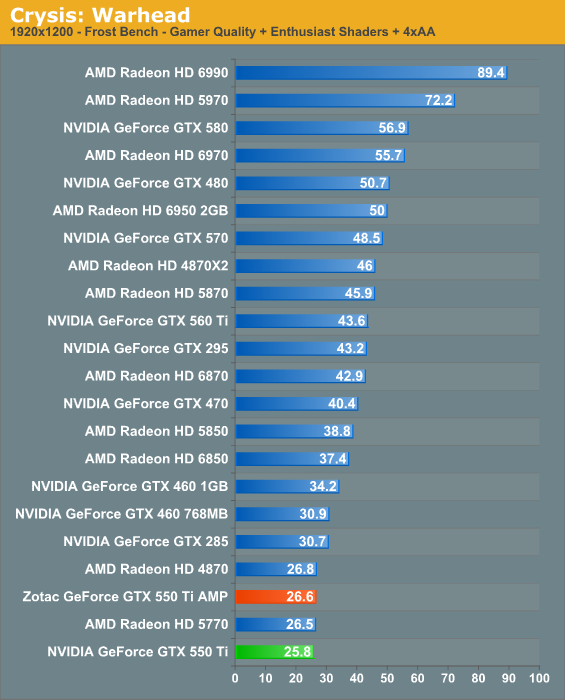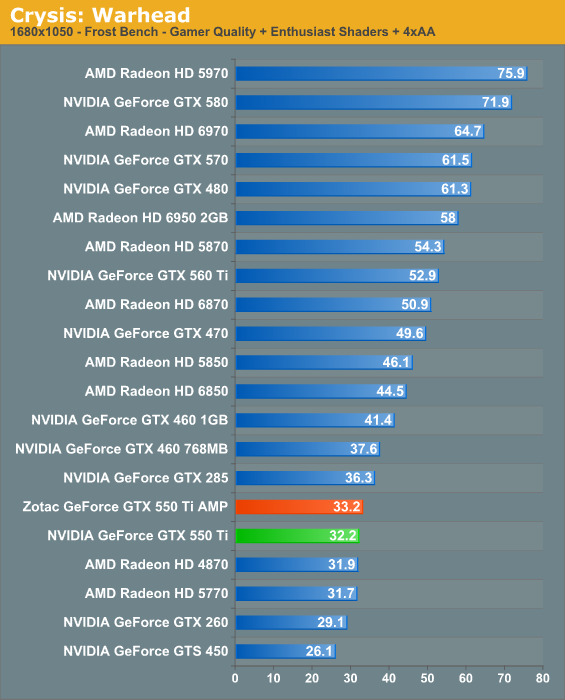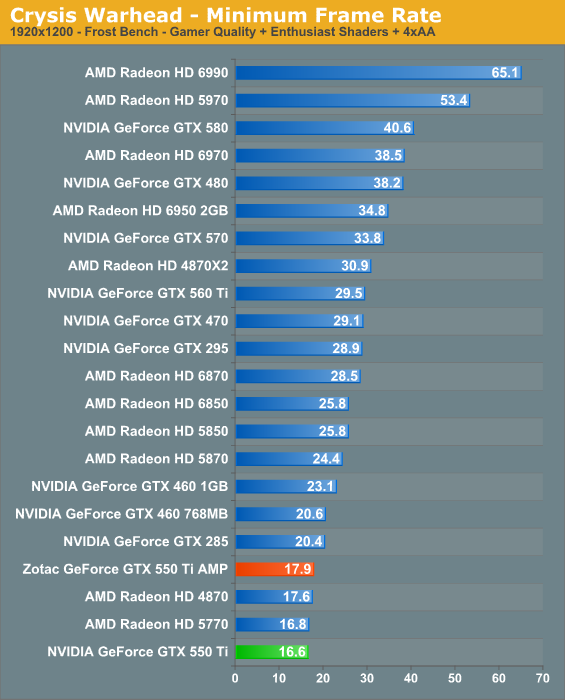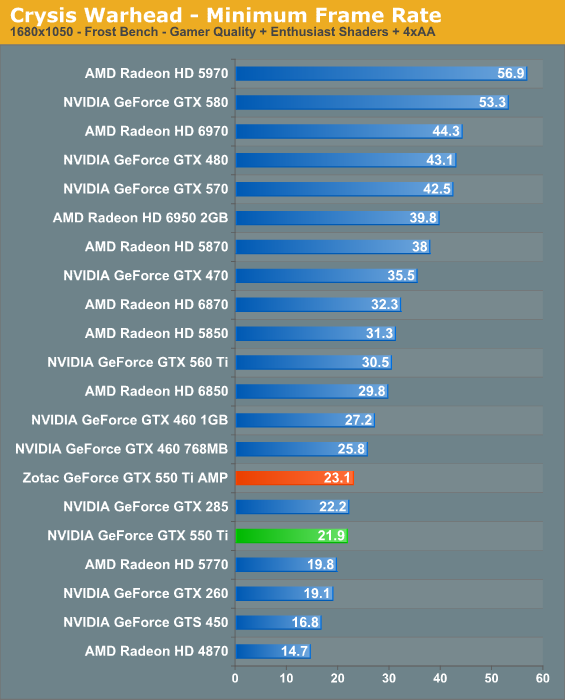NVIDIA's GeForce GTX 550 Ti: Coming Up Short At $150
by Ryan Smith on March 15, 2011 9:00 AM ESTCrysis: Warhead
Kicking things off as always is Crysis: Warhead, still one of the toughest game in our benchmark suite. Even 3 years since the release of the original Crysis, “but can it run Crysis?” is still an important question, and for 3 years the answer was “no.” Dual-GPU halo cards can now play it at Enthusiast settings at high resolutions, but for everything else max settings are still beyond the grasp of a single card.


Though NVIDIA is primarily targeting the GTX 550 Ti towards 1680x1050 users, we’re including 1920x1200 to showcase games where the card is fast enough to handle that higher resolution at a playable framerate, or to show where it’s close to crossing the mark. However this is largely to satisfy our curiosity rather than to generate data from which to draw a comparison.
Out of our normal card lineup the GTS 450 is the slowest card we keep, so NVIDIA quite literally has nowhere else to go but up here. For the GTX 550 this means vaulting well past the GTS 450, giving us a 23% increase in performance; keep in mind that the theoretical improvement based on core and memory clocks alone is only 15%, so whenever we exceed that we are clearly seeing the benefits of the additional ROPs, L2 cache, and memory bandwidth afforded by enabling the 3rd memory controller. In any case at 32.2fps it’s playable, however Crysis is a demanding enough game that it makes much more sense to turn the game’s settings down some more before taking it on.
Meanwhile compared to AMD’s offerings the GTX 550 comes out ahead of the 5770 by half a frame per second, while the 6850 completely clears the field - –he GTX 550 only manages 72% of the 6850’s performance here. The situation compared to the GTX 460 768MB is much better, but still the GTX 550 is only 85% as fast.
As for the Zotac factory overclock, here we’re picking up 3%. This is curiously much lower than the theoretical advantage.


In terms of minimum framerates the GTX 550 ends up doing better. It ends up being ahead of the 5770 by nearly 10%, and against the 450 it beats it by 30%. However the GTX 550 still falls short of the 6850 by nearly 25%.










79 Comments
View All Comments
Ryan Smith - Tuesday, March 15, 2011 - link
Our experience with desktop Linux articles in the past couple of years is that there's little interest from a readership perspective. The kind of video cards we normally review are for gaming purposes, which is lacking to say the least on Linux. We could certainly try to integrate Linux in to primary GPU reviews, but would it be worth the time and what we would have to give up in return? Probably not. But if you think otherwise I'm all ears.HangFire - Tuesday, March 15, 2011 - link
All I'm asking for is current and projected CUDA/OpenCL level support, and what OS distro's and revisions are supported.You may not realize it, but all this GPGPU stuff is really used in science, government and defense work. Developers often get the latest and greatest gaming card and when it is time for deployment, middle end cards (like this one) are purchased en masse.
Nividia and AMD have been crowing about CUDA and OpenCL, and then deliver spotty driver coverage for new and previous generation cards. If they are going to market it heavily, they should cough up the support information with each card release, we shouldn't have to call the corporate rep and harangue them each and every time.
Belard - Wednesday, March 16, 2011 - link
Someone who already has a GF450 would be a sucker to spend $150 for a "small-boost" upgraded card.When upgrading, a person should get a 50% or better video card. A phrase that never applies to a video card is "invest" since they ALL devalue to almost nothing. Todays $400~500 cards are tomorrows $150 cards and next weeks $50.
So a current GF450 owner should look at a GF570 or ATI 6900 series cards for a good noticeable bump.
mapesdhs - Wednesday, March 16, 2011 - link
Or, as I've posted before, a 2nd card for SLI/CF, assuming their mbd
and the card supports it. Whether or not this is worthwhile and the
issues which affect the outcome is what I've been researching in recent
weeks. Sorry I can't post links due to forum policy, but see my earlier
longer post for refs.
Ian.
HangFire - Friday, March 18, 2011 - link
I wasn't really suggesting such an upgrade (sidegrade). I was just saying that each generation card at a price point and naming convention (450->550) should have at least a little better performance than card it replaces.Calabros - Tuesday, March 15, 2011 - link
tell me a reason to NOT prefer 6850 over this7Enigma - Tuesday, March 15, 2011 - link
So basically this is my 4870 in a slightly lower power envelope with DX11 features. I'm shocked the performance is so low honestly. Thanks for including the older cards in the review because it's always nice to see I'm still chugging along just fine at my gaming resolution (1280X1024) 19".7Enigma - Tuesday, March 15, 2011 - link
Forgot to add, which I bought in Jan 2009 for $180 (Sapphire Toxic 512meg VaporX, so not reference design)mapesdhs - Tuesday, March 15, 2011 - link
You're the target audience for the work I've been doing, comparing cards at
that kind of resolution, old vs. new, and especially where one is playing older
games, etc. Google for, "Ian PC Benchmarks", click the 1st result, then select,
"PC Benchmarks, Advice and Information". I hope to be able to obtain a couple
of 4870s or 4890s soon, though there's already a lot of 4890 results included.
Ian.
morphologia - Tuesday, March 15, 2011 - link
Why in the name of all that's graphical would you use this Noah's Ark menagerie of cards but leave out the 4890? It doesn't make sense. If you're going to include 4000 series cards, you must include the top-of-the-line single-GPU card. It's proven to be quite competitive even now, against the lower-level new cards.